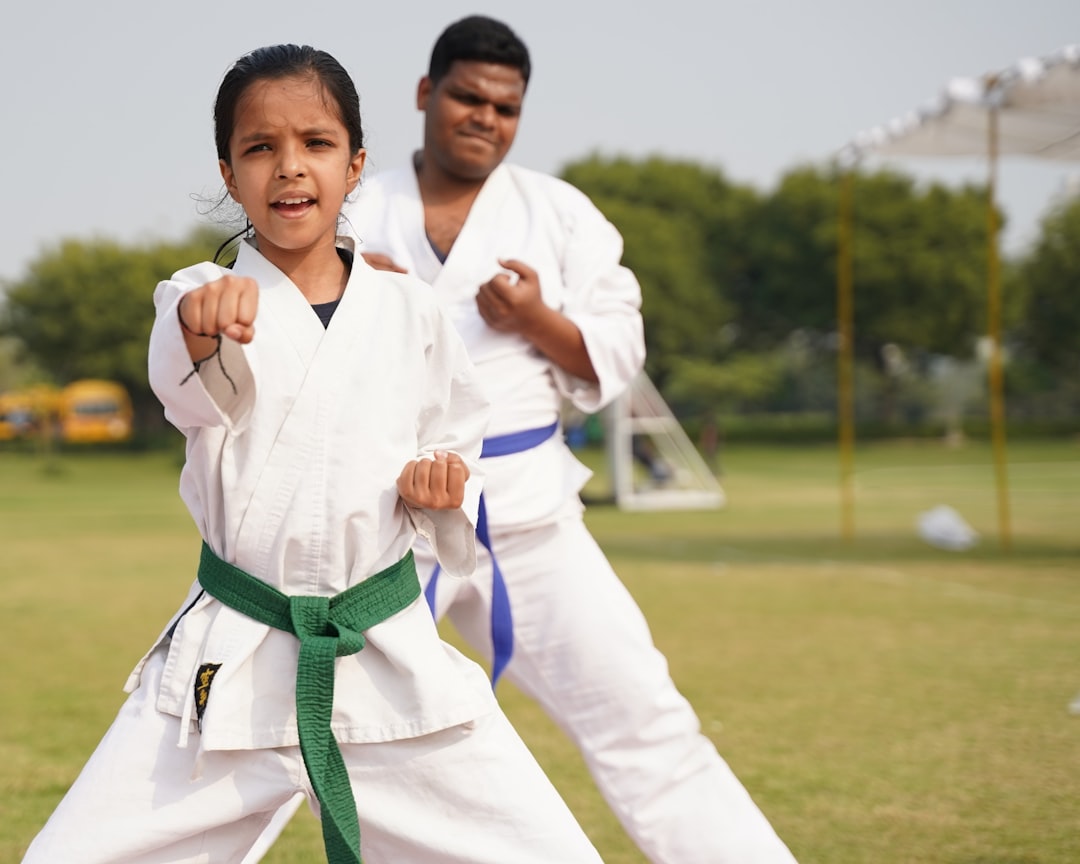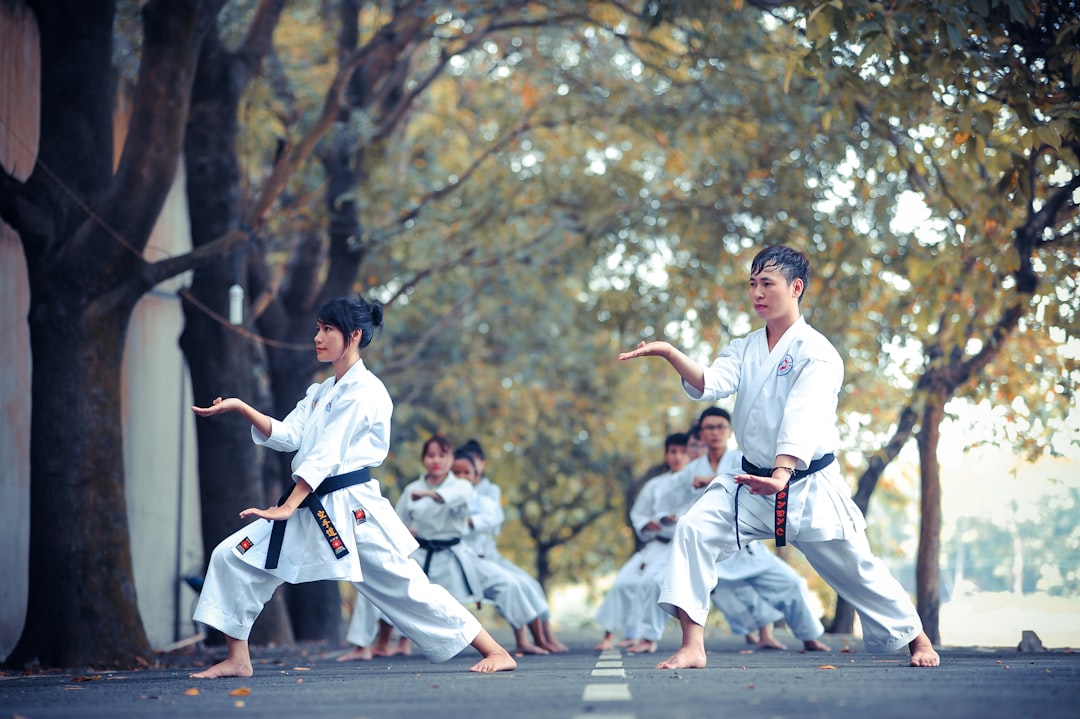When training karate from home, selecting a well-fitting karate gi that strikes a balance between comfort and functionality is crucial for optimal performance. The ideal gi should be made of durable and breathable fabric, allowing full range of motion while you practice your kata and exercises. It should also be respectful to the discipline, signifying reverence for traditional martial arts practices. When it comes to footwear, choose either flat-soled shoes or specialized karate dobok that protect your flooring and ensure safety during training. The choice between different types of footwear depends on your home training space's surface and your personal comfort. Ensuring a safe and appropriate environment for practice is essential, as it will influence your decision on the type of attire and footwear best suited for your home dojo sessions. Adhering to these attire and environmental considerations will enhance your karate practice at home, providing a respectful, effective, and injury-free training experience.
Embark on a journey through the disciplined world of karate, where the practitioner’s attire plays a pivotal role in both form and function. Known colloquially as a “karate gi,” this garment is more than mere uniform; it’s a symbol of respect and readiness for the martial arts enthusiast who trains karate home. In this article, we will explore the essential qualities of a karate gi, guide you through selecting the ideal attire for your home dojo, and delve into how appropriate training garb enhances your practice and ensures safety. Whether you’re a seasoned martial artist or a beginner, understanding the significance of your karate uniform will elevate your home training sessions to new heights.
- Karate Uniform Essentials: Donning Your Gear for Home Training Sessions
- Choosing the Right Karate Gi for Your Home Dojo: A Comprehensive Guide
- Maximizing Your Karate Home Practice: The Role of Proper Attire and Safety Considerations
Karate Uniform Essentials: Donning Your Gear for Home Training Sessions

When setting up your space for train karate home sessions, one of the foundational elements is your attire. A karate uniform, also known as a gi, serves as more than just a garment; it’s a symbol of respect and tradition within the martial arts community. Choosing the right gi is crucial for both comfort and function, ensuring you have the freedom to move through each kata and exercise with ease. The top half of the gi, known as the jacket or “uchiwa,” should fit snugly without restricting your arm movements, while the trousers, or “rei-oshi,” need to be neither too tight nor too loose to allow for full range of leg motion. Additionally, the fabric should be durable yet breathable, facilitating optimal performance during your home training sessions. Is the gi you have suitable for the intensity and scope of your train karate home practice? If not, consider investing in one that meets these requirements, as it can significantly enhance your training experience.
Proper attire also includes footwear; many practitioners opt for karate dobok, which often come with a belt, or you may wear flat-soled shoes that won’t mark the floor. The choice largely depends on the type of surface you’re training on and personal comfort. Do you have a dedicated space for your home train karate sessions where the floor is safe to practice without special footwear? Assessing your environment will help determine what’s necessary for your practice. Remember, the key to effective home training is not just about the moves you perform but also the respect you show to the discipline through your preparation and presentation.
Choosing the Right Karate Gi for Your Home Dojo: A Comprehensive Guide

When training karate at home, selecting the appropriate attire is crucial to ensure comfort and adherence to traditional practices. A karate gi, often referred to as a judogi, is not just a uniform but also a symbol of respect for the martial art. It’s important to choose a gi that aligns with the specific requirements of your style of karate, as different disciplines may have varying preferences for color and cut. For instance, does your home dojo adhere to specific gi color codes? Is the weave of the fabric appropriate for the intensity of your training sessions? Opting for a heavy cotton gi is often recommended for its durability and breathability, which are essential factors when practicing in a home environment without air conditioning. Does the gi offer a good balance between mobility and coverage to perform techniques effectively without causing unnecessary distractions? Additionally, consider the fit; a well-fitted gi should not be too tight or too loose, allowing for a full range of motion while maintaining respect for the tradition.
Furthermore, when sourcing your home dojo karate gi, it’s beneficial to look for reputable brands that specialize in martial arts apparel. These brands often provide a selection of gis tailored for various body types and training intensities. How will you wash and maintain your gi to ensure its longevity? Proper care is essential to keep the garment in good condition, which means choosing a gi that can withstand regular laundering without shrinking or losing its shape. Remember, the right karate gi not only sets the tone for your training but also supports your performance and comfort during every session.
Maximizing Your Karate Home Practice: The Role of Proper Attire and Safety Considerations

When training karate at home, selecting the right attire is crucial for both performance and safety. A traditional karate uniform, commonly known as a gi, is not merely a piece of apparel but an integral component of the practice, offering a range of benefits that contribute to effective training. The gi provides flexibility and allows for ease of movement, which is essential when executing precise and dynamic techniques. Moreover, it facilitates the learning process by ensuring that the body’s alignment and posture are visible for form correction. Are you looking to optimize your karate home practice? Consider how a proper gi can enhance your technique and safety.
In terms of safety, certain precautions must be taken when practicing karate without an instructor’s supervision. The gi should fit correctly to avoid tripping hazards or hindering movements that could lead to injury. Additionally, ensure that the training area is free from potential hazards like sharp objects or unstable furniture. Do you practice karate at home often? Make sure your environment is safe and conducive to learning and improvement. Proper attire, a clear space, and an understanding of safety measures are key to maximizing the benefits of your home training sessions.
When training karate at home, selecting an appropriate uniform, commonly referred to as a ‘Gi,’ is key to ensuring both performance and safety. This article has delved into the essential characteristics of a quality Gi, offering guidance on how to choose one that suits your needs for home training sessions. By understanding the importance of material, fit, and functionality, you can optimize your practice environment and enhance your karate experience. Remember, whether you’re an experienced practitioner or just starting out with train karate home exercises, the right attire can make all the difference in your progress and comfort.
